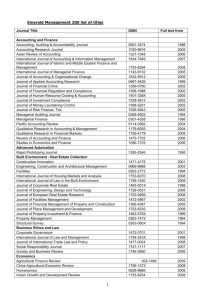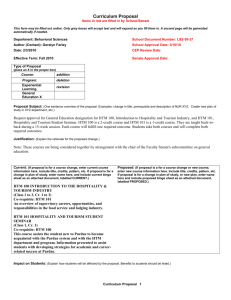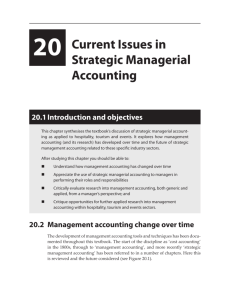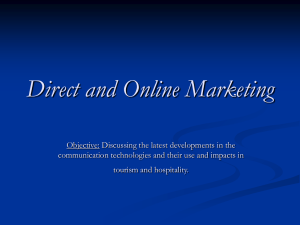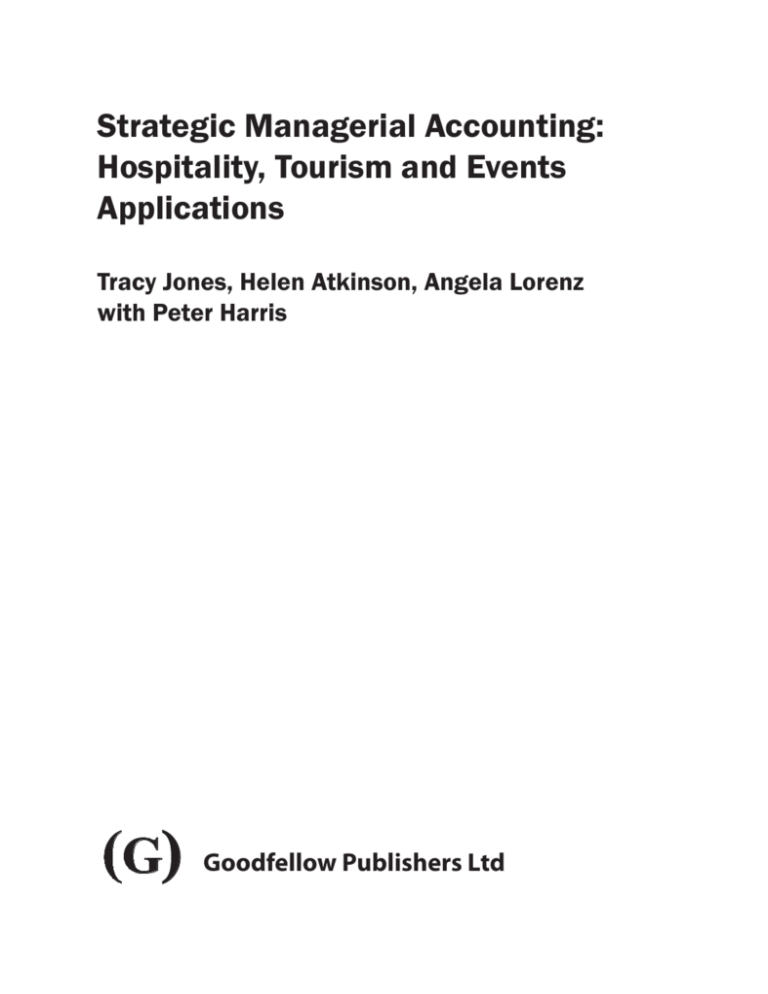
Strategic Managerial Accounting:
Hospitality, Tourism and Events
Applications
Tracy Jones, Helen Atkinson, Angela Lorenz
with Peter Harris
(G)
Goodfellow Publishers Ltd
(G)
Published by Goodfellow Publishers Limited, Woodeaton, Oxford, OX3 9TJ
http://www.goodfellowpublishers.com
British Library Cataloguing in Publication Data: a catalogue record for this
title is available from the British Library.
Library of Congress Catalog Card Number: on file.
ISBN: 978-1-908999-01-6
Copyright © Tracy Jones, Helen Atkinson, Angela Lorenz, Peter Harris, 2012
All rights reserved. The text of this publication, or any part thereof, may not
be reproduced or transmitted in any form or by any means, electronic or
mechanical, including photocopying, recording, storage in an information
retrieval system, or otherwise, without prior permission of the publisher or
under licence from the Copyright Licensing Agency Limited. Further details
of such licences (for reprographic reproduction) may be obtained from the
Copyright Licensing Agency Limited, of Saffron House, 6–10 Kirby Street,
London EC1N 8TS.
All trademarks used herein are the property of their repective owners, The
use of trademarks or brand names in this text does not imply any affiliation
with or endorsement of this book by such owners.
Design and typesetting by P.K. McBride, www.macbride.org.uk
Cover design by Cylinder, www.cylindermedia.com
Contents
Foreword by Professor Peter Harris
Preface to the Sixth Edition
viii
ix
1
A Strategic Managerial Accounting Perspective to Hospitality, Tourism and Events Operations
1
1.1
1.2
1.3
1.4
1.5
Introduction and objectives
Defining accounting and finance
The hospitality, tourism and events focus
Characteristics of hospitality, tourism and events
The role of managers in strategic managerial accounting
Summary of key points
1
1
4
6
10
10
2
Financial Statements for Decision Making
12
2.1
2.2
2.3
2.4
2.5
2.6
Introduction and objectives
Alternative accounting statements The difference between profit and cash
Key external financial reporting frameworks – IFRS
Key management accounting reporting framework – USALI
The purpose of such statements in aiding managers
Summary of key points
12
13
13
15
21
26
26
3
Costs and their Behaviour
28
3.1
3.2
3.3
3.4
Introduction and objectives
Classifying costs
Behaviour – fixed, variable and semi-variable costs Cost concepts, analysis and applications
Summary of key points 28
29
32
35
44
4
Cost Volume Profit Analysis (CVP)
47
4.1
4.2
4.3
4.4
4.5
Introduction and objectives
CVP terminology and concept
CVP calculations
CVP in an industry context
Computerised ‘What if?’ analysis
Summary of key points
47
47
49
58
59
66
iv
5
Strategic Managerial Accounting
Short-term Decision Making
68
5.1
Introduction and objectives
5.2
Relevant costs in decision making
5.3
Opportunity costs
5.4
Differences between short-term and long-term decisions
5.5
Types of short-term decisions
5.6
Long-term implications of short-term decisions
5.7
Scarce resources
5.8
Uncertainty 5.9Outsourcing
Summary of key points
68
68
69
70
70
74
75
76
76
77
6
Pricing Decisions
79
6.1
6.2
6.3
6.4
Introduction and objectives
Pricing approaches
Relationship of cost/cost structure to price
Developing a pricing strategy
Summary of key points
79
79
89
90
90
7
Revenue and Yield Management
92
7.1
7.2
7.3
7.4
7.5
Introduction and objectives
The concept of revenue management
Characteristics for revenue management
Revenue management in different environments
Revenue maximisation or profit maximisation?
Summary of key points
92
93
95
99
100
101
8
Costing and Customer Profitability Analysis
103
8.1
8.2
8.3
8.4
8.5
8.6
8.7
Introduction and objectives
Market decisions
The accounting/marketing interface
Activity-Based Costing (ABC)
Activity-based management (ABM)
Customer profitability analysis (CPA)
Profit sensitivity analysis (PSA)
Summary of key points
103
103
105
107
109
110
113
117
9
The Use of Budgets in Organisations
119
9.1
Introduction and objectives
119
Contents
9.2
9.3
9.4
9.5
9.6
The role of budgets
Master budget preparation
Budgetary control
Behavioural aspects of budgeting
Beyond Budgeting/Better Budgeting
Summary of key points
v
120
121
132
138
141
144
10 Event and Function Management Acounting Techniques
148
10.1
10.2
10.3
10.4
10.5
148
148
149
154
157
160
Introduction and objectives
Features of the events and function sector Event planning phase management accounting tools
Management accounting tools for use during the event
Post-event performance review management accounting tools Summary of key points
11 Financial Analysis of Performance 162
11.1
11.2
11.3
11.4
11.5
11.6
11.7
11.8
11.9
162
163
163
167
172
173
175
182
184
190
Introduction and objectives
Methods of analysis
Scanning, trend analysis and time series Comparative and common-size statement analysis
Types of ratios
Ratio analysis illustration
Financial ratios Interpretation of results
Operating ratios Summary of key points
12 Working Capital Management
12.1
12.2
12.3
12.4
12.5
12.6
12.7
12.8
12.9
193
Introduction and objectives
193
Understanding working capital
193
Working capital financing policy
195
Working capital characteristics
196
Working capital ratios
197
Management of inventory
200
Managing accounts receivable
205
Managing accounts payable
209
Management of cash 209
Summary213
vi
Strategic Managerial Accounting
13 Business Finance
13.1
13.2
13.3
13.4
13.5
13.6
215
Introduction and objectives
215
Short-term sources of finance
215
Long-term sources o f finance
217
The weighted average cost of capital (WACC)
220
SMEs and micro businesses
221
Sector-specific financing
222
Summary224
14 Capital Investment Appraisal
227
14.1
14.2
14.3
14.4
14.5
14.6
14.7
14.8
14.9
14.10
14.11
14.12
227
227
228
229
230
232
234
235
236
238
239
239
240
Introduction and objectives
The value of investment appraisal
Example data
Accounting rate of return (ARR)
Payback period (PBP)
The time value of money
Discounted payback period
Net present value (NPV)
Internal rate of return (IRR)
Profitability index
Uncertainty in investment projects
Integrated strategic approaches
Summary of key points
15 Performance Measurement 243
15.1
15.2
15.3
15.4
15.5
243
243
245
250
252
254
Introduction and objectives Performance measurement history and development
Key frameworks and models
Performance measurement in hospitality, tourism and events industries Benchmarking performance
Summary of key points
16 Strategic Management Accounting
257
16.1
16.2
16.3
16.4
16.5
16.6
257
258
259
260
261
263
Introduction and objectives
Why strategic management accounting? Definitions and evolution
Linking strategy and accounting (strategic versus traditional accounting)
Boston Matrix, risk return and cash
Value generation and value drivers Product lifecycle, profit cash and investment
Contents
16.7
16.8
16.9
The Balanced Scorecard (BSC) Activity-based management (ABM)
Other management accounting tools considered to be strategic
Summary of key points
vii
266
266
267
268
17 Critical Success Factors and Management Information Needs
270
17.1
17.2
17.3
17.4
17.5
270
270
273
274
276
278
Introduction and objectives
Management information needs
Defining critical success factors (CSFs)
The relationship between goals, CSFs and measures
The use of CSFs in an organisation
Summary of key points
18 Sustainability and Environmental Management Accounting 280
18.1
18.2
18.3
18.4
18.5
280
281
282
283
288
289
Introduction and objectives
The triple bottom line (people, planet and profits)
Managing a sustainable business
EMA reporting
Environmental management accounting guidelines
Summary of key points
19 Not-for-profit Organisations
292
19.1
19.2
19.3
19.4
292
292
294
295
300
Introduction and objectives
Defining a not-for-profit organisation
Their significance to the hospitality, tourism and events sectors
The implications for management accounting approaches
Summary of key points
20 Current Issues in Strategic Managerial Accounting
302
20.1 Introduction and objectives
20.2 Management accounting change over time
20.3 Use of management accounting in hospitality, tourism and events
20.4 The role of the management accountant
20.5 Contemporary applied research
20.6 Managerial accounting and the reader
Summary of key points
302
302
303
305
306
308
309
311
Answers to self-check questions Index
321
viii
Strategic Managerial Accounting
Foreword by Professor Peter Harris
This book was first published in 1972 as the second of two volumes, entitled
Accounting & Financial Management in the Hotel and Catering Industry Vol.I (accounting) and Vol.II (financial management). Vol.I was revised three times, to 1987 and
Vol.II revised four times, to 1992.
During their period in publication the structure and content of the volumes
underwent a transformation in line with the evolving role of professional hospitality managers and developments in the wider field of accounting; resulting in
the volumes being developed latterly as independent titles. With the evolution of
management accounting and the growing emphasis on managers understanding
the financial implications of planning and business decisions Vol.II was revised
and retitled Managerial Accounting in the Hospitality Industry, 5th edition, 1992.
Throughout the period of the Harris and Hazzard editions we researched,
developed and applied emerging, state-of-the-art, generic accounting methods
in order to give greater financial insights into hospitality products and services
and improve the effectiveness of managers’ decision-making. Peter Hazzard’s
contribution to this process was invaluable, enabling the adaptation and transfer
of accounting techniques, traditionally used in production and manufacturing
industry, to hospitality sectors of the service industry.
Now, alongside hospitality, the growth in tourism and recent emergence of
the events sector makes it timely and relevant to encompass these additional,
complementary, service sectors in a single integrated managerial accounting
text. Who better to achieve such an undertaking, and take the work forward to
a new generation of students and managers, than the three authors of this new
landmark edition!
Tracy Jones, Helen Atkinson, and Angela Lorenz are three talented academics
whose backgrounds combine professional accounting, service-sector management
practice and extensive research and teaching experience. Their knowledge and
understanding of hospitality, tourism and events management shines through
the explanations, examples, and illustrations presented in the text. I congratulate
their results and commend this title.
Peter Harris
Professor Emeritus of Accounting and Financial Management
Oxford School of Hospitality Management
Faculty of Business
Oxford Brookes University
8th August, 2012
ix
Preface to the Sixth Edition
Previously published as Managerial Accounting in the Hospitality Industry by Harris
and Hazzard, this book has a history of over 30 years. With new authors, this
edition has been rewritten, expanded and updated to meet the needs of a modern
audience.
There are a number of key changes since the last edition, with many new
chapters to keep abreast of current accounting developments. The application of
the text has also been expanded to cover various hospitality, tourism and event
uses of management accounting, from a management perspective. Management
accounting is a specific discipline within accounting, this text takes management
accounting tools, but views them from the perspective of managers, hence the
title of Managerial Accounting, not management accounting.
Structure of chapters
Each chapter of the book has a number of standard key features. All chapters
start with a section ‘Introduction and objectives’; which gives an overview of the
purpose and learning objectives of the chapter. At the end of each chapter there
is a ‘Summary’ of the key points from the chapter. Every chapter consciously
considers the theoretical context of the subject under discussion. The summary
section in chapters is followed by ‘References’ and advice for ‘Further reading’ to
develop a deeper understanding in specialist aspects of the chapter. The ‘Student
self-check questions’ section aids checking understand and knowledge of the
chapter contents. If applicable, this section includes a numerical question where
the student can check their own answers. A ‘Further problems’ section completes
each chapter, the answers to these are available online as part of the book’s online
resource package.
Online additional resources
This textbook is supported by a number of online resources. For students, the
answers to problem questions are available online. For registered tutors, lecture
slides, further problems, and answers will aid the use of this book as a core text
for many applied undergraduate and postgraduate classes.
Use of hospitality, tourism and events examples
A variety of illustrative examples are used throughout this book. There is a
balance of examples covering: local, national and international organisations;
commercial and non-commercial organisations; hospitality examples, including
various hotel and restaurant illustrations; tourism examples, including transportation, tour operation and tourist facility management; and event sector examples, including music events, festivals, weddings, sporting events, and charitable
x
Strategic Managerial Accounting
events. Where specific management accounting techniques lend themselves more
to a specific sector or environment this is stated. Generally, unless specifically
mentioned, techniques discussed in the book can be equally applied across these
service sector environments (hospitality, tourism and events), the use of a specific
example is for illustration of concepts and methods more generally. The authors
have experience of teaching students within all these industry sectors and this is
reflected in the wide range of examples used within this text.
Specific notes
Each chapter covers a specific topic, some including many numerical calculations,
and need much additional supporting explanation, whilst others are more discursive in nature. Given this, chapters do vary considerably in length. The authors
have taken a positive decision not to combine some shorter topics into single
chapters, or split some topics over two chapters to artificially manage chapter
length.
This text focuses on managerial accounting, managers’ use of accounting
information within organisations. No discipline has a fixed boundary and management accounting does have strong links to aspects of operations management,
marketing, financial accounting and financial management. Within this text these
links are made to aid students and managers’ in fully understanding aspects of
management accounting. An example of this is the inclusion of a chapter concerning financing businesses. This chapter supports the users of this text in having a
more holistic view of the implications of financing options in relation to managerial accounting implications and decision making.
As managerial accounting focuses on the internal use of accounting information to aid managers, generally it is not concerned with matters of external financial reporting. With this in mind, matters of taxation, including VAT, are excluded
when discussing topics such as pricing calculations, as is common within other
management accounting texts.
We would like to thank those that have allowed us to use their financial data
and information to provide ‘real life’ examples within this text. Thanks also to
HOSPA (formerly BAHA) for allowing the use of questions from their Strategic
Management Accounting exam papers.
Tracy Jones, Helen Atkinson, and Angela Lorenz
July 2012

